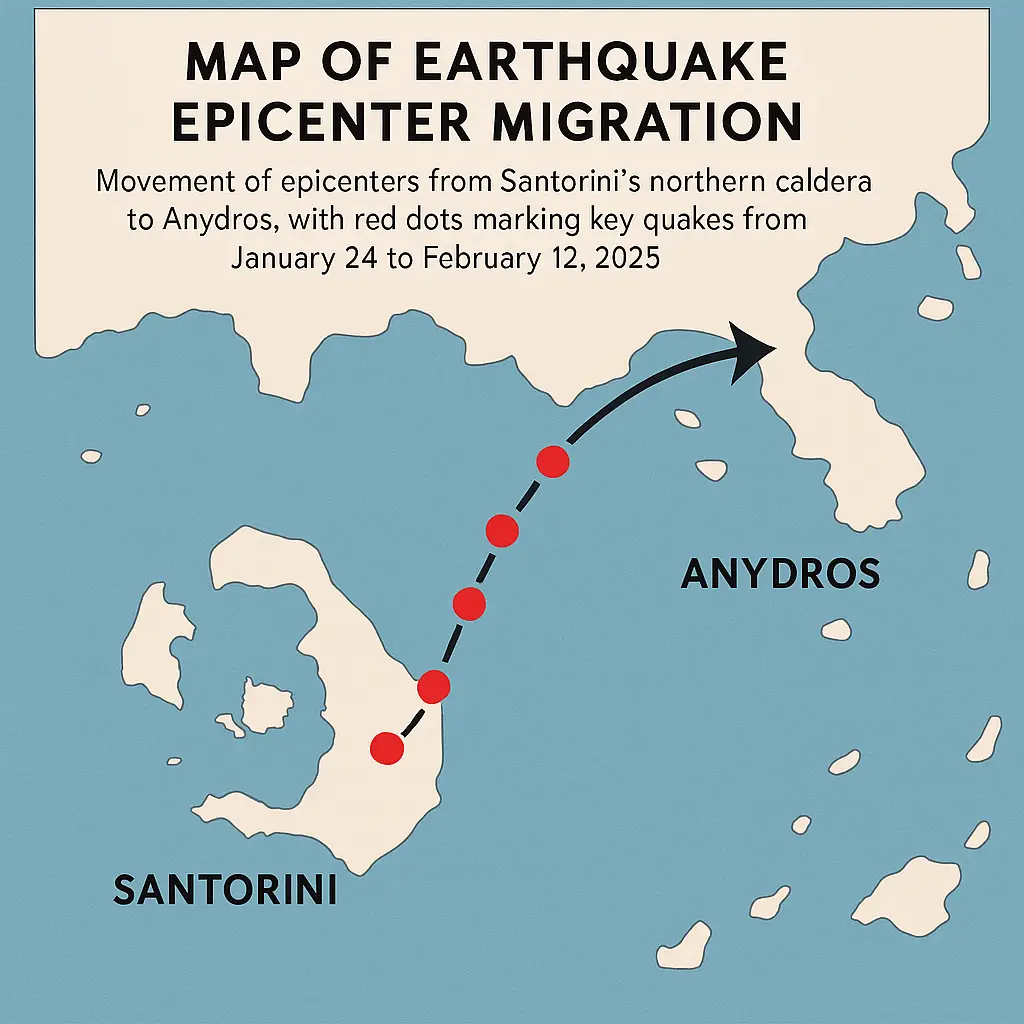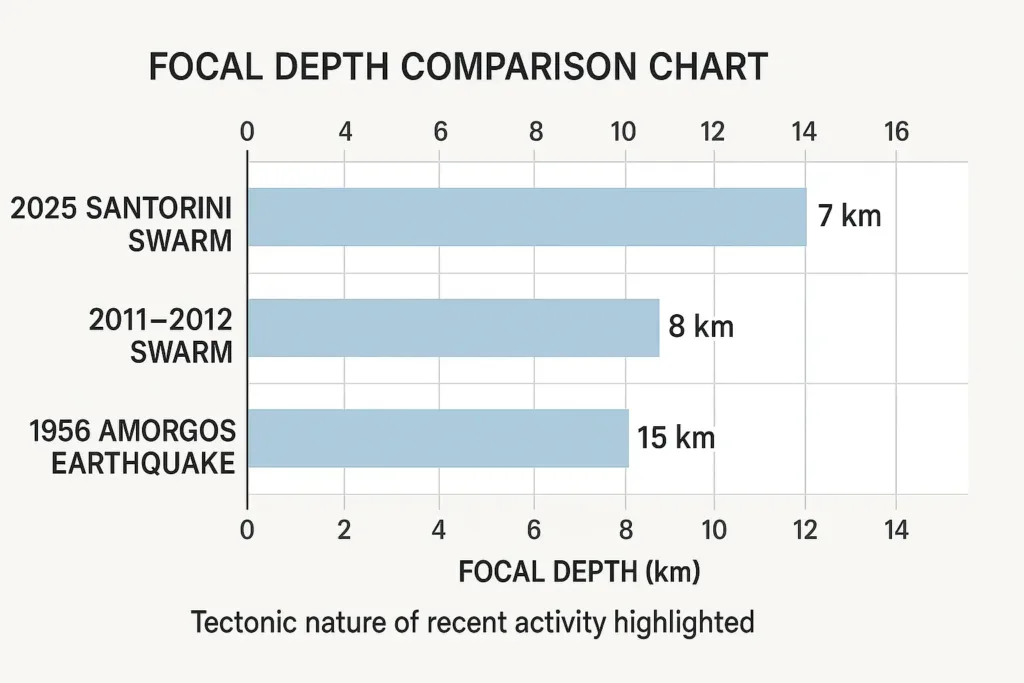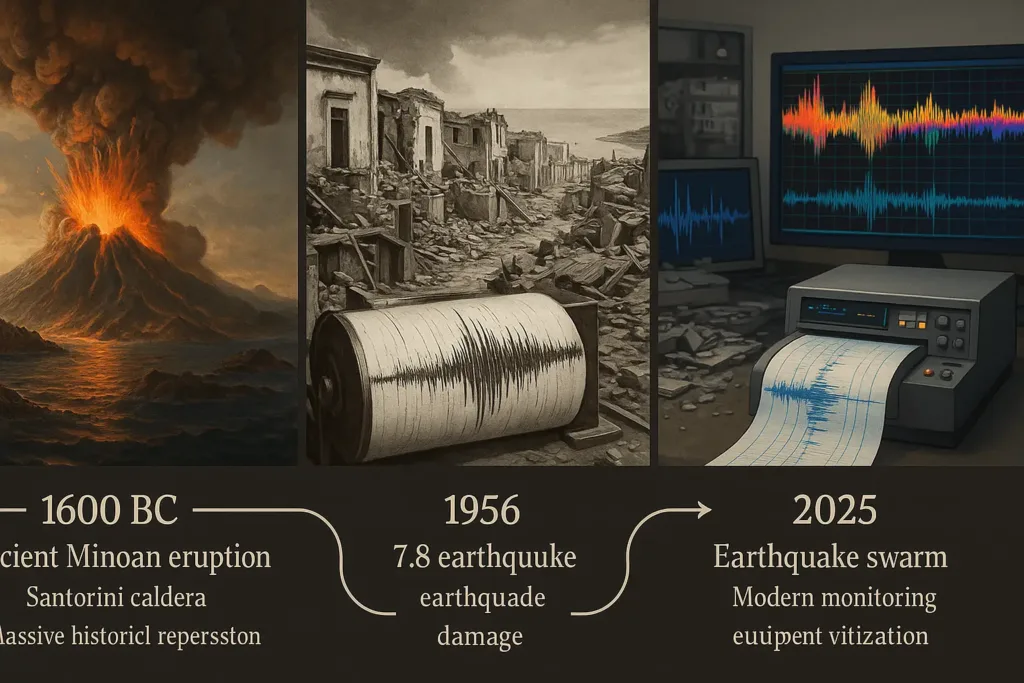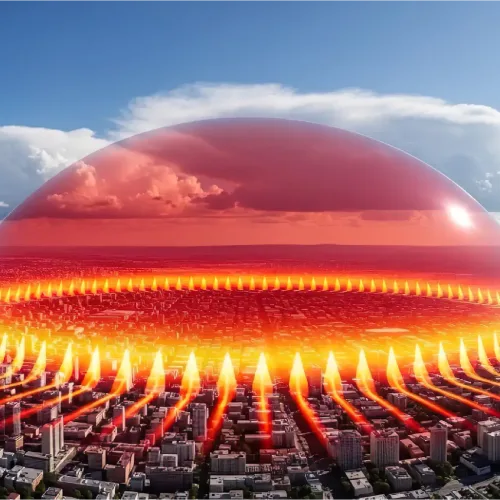The famous Greek island Santorini, known for its stunning sunsets and dramatically perched cliffside villages, is now facing an unprecedented earthquake crisis. Since January 24, 2025, this volcanic island in the Aegean Sea has experienced several unusual small and large earthquake swarms. The strongest one recorded had a magnitude of 5.3. More than 12,800 earthquakes have been recorded since January, with the biggest one happening on February 10th. That’s why this region has drawn global attention, and these seismic activities have raised many questions about the potential threat of a volcanic eruption. The Santorini earthquake swarm points to something far more significant than just the Earth shaking. These earthquake tremors raise serious concerns for the region’s tourism, geology, and the safety of its local residents. Experts say that the Aegean Sea has a complex setup where two tectonic plates meet, which leads to the formation of earthquakes and volcanic activities.
In this blog post, we will explore the facts using seismological data, historical context, and expert’s research to understand what is happening under the surface of Santorini. Whether you are a tourist, a science lover, or a curious mind, there is a lot to learn. Join us and let’s dive in!
What’s an Earthquake Swarm?
An earthquake swarm is a series of small tremors that occur in a specific region over a short period of time. Unlike a typical earthquake, these swarms usually consist of multiple small quakes rather than one single large shock. These tremors are often linked to the movement of fluids under the surface of Earth’s crust or to the localized tectonic stress.
To understand this concept better, let’s use a single example. Imagine a pot of water boiling on a stove. Instead of a single large splash, you see many small bubbles continuously rising to the surface. These small bubbles are like the tiny tremors in an earthquake swarm-large, frequent, and spread over s short time, rather than one large quake.
Key characteristics of earthquake swarms include:
- Multiple earthquakes of comparable size
- No clear mainshock-aftershock pattern
- Sustained activity over extended periods
- Often linked with volcanic regions or fluid movement
These swarms can happen because of plate movement or because of magma or gas moving. Santorini earthquake swarm is a volcano. Right now, it looks like the 2025 swarm is mostly caused by plate movement. Some fluid effects might still be possible.
Famous Swarm Examples:
- Yellowstone, USA – recurring swarms linked to deep magma movements
- Kefalonia, Greece – 2022–23 swarm analyzed using machine learning
- Bardarbunga, Iceland – swarm preceded a major eruption in 2014
Timeline & Scale of the 2025 Santorini Earthquake Swarm
The 2025 Santorini earthquake swarm not only affected the local residents but also surprised and disturbed scientists.
1. January 2025
On January 24, several small to medium earthquakes were recorded in the regions around the Greek island of Santorini. According to a report, researchers noticed more shaking in the area on January 26. The early quakes were minor, below magnitude 3.0, and most people didn’t even feel them.
2. Early February 2025
As time passed, the situation rapidly deteriorated. By January 28, more than 130 earthquakes had been felt, with magnitudes greater than three. Since conditions had been observed on the summit areas of Santorini that made the risk of volcanic eruptions possible, an emergency meeting of experts was called to discuss the situation.
3. Mid-February Peak Activity
On February 10, a severe earthquake occurred, with a magnitude of more than 5.3. It was the strongest tremor ever recorded, which created an emergency situation and damaged many areas.

Emergency Response
These severe earthquakes spread fear and panic among the locals. Tourists present at the scene were also affected. This led to an emergency situation. Thousands of people left the island and migrated to other areas. According to Greek authorities, they have taken several safety measures, including closing schools and sending emergency teams.
Inside the Numbers: Seismological Analysis
Seismological data from the 2025 Santorini earthquake revealed intriguing patterns. The B value, which measures the ratio between small and large earthquakes, went down, which means there was more stress on the Earth’s crust. At the same time, the fractal dimension (Dc) increased. This indicates that small earthquakes come together in a group to release large amounts of energy. Other measurements pointed to complex fault interactions, with the average location of earthquake energy shifting up and down at depths of 4-10 kilometers. These results, based on improved analysis of the data, show that tectonic activity, not volcanic activity, was the primary cause, although fluid movement along faults was still a key consideration. You can learn more about data analysis methods on our Biology Education page.
The following table summarizes key seismological metrics:
| Metric | Observation | Implication |
|---|---|---|
| B-value | Declined | Increasing crustal stress |
| Fractal Dimension (Dc) | Increased | Clustering of smaller quakes |
| Scaling Exponent αb | Complex trends | Fault interactions |
| Seismic Barycenter | Vertical migration (4–10 km) | Tectonic stress at shallow depths |
Machine Learning & Fluid Involvement
Machine learning has played a key role in monitoring the Santorini earthquake swarm of 2025. The algorithm developed by the British Geological Survey has detected more than 20,000 quakes since December 2024. This is ten times more than standard methods. It offers high-resolution insights into fault dynamics. Comparisons with the 2017 Kefalonia quake indicate a fluid-driven earthquake, where the movement of water or carbon dioxide along faults triggers the earthquake. In the Santorini-Amorgos sequence, the epicenters are aligned with the Colombo and Kamini fault systems, supporting this hypothesis. Although magma movement was not identified, ongoing monitoring is essential to rule out a volcanic contribution.
Tectonics, Volcanoes & Tsunami Risk
Santorini sits in a pretty interesting spot where the African Plate is sliding under the Eurasian Plate. This movement creates faults and stretches the ground—kind of like what we see with the Santorini–Amorgos graben. Now, the earthquakes that happen around here usually occur at depths of about 4 to 10 kilometers, which hints more at tectonic pressure than volcanic stuff going on. And, as far as we can tell, there aren’t any signs of ground changes or magma bubbling up.
But here’s the kicker: there’s Kolumbo, a submarine volcano just 6.5 kilometers northeast of Santorini. This one’s a bit worrisome because it had an eruption back in 1650 that led to tsunamis and fast-moving flows of hot gas and rock. According to some studies by UNESCO, those waves could reach up to 22 meters in extreme situations. But don’t freak out just yet—the chances of that happening right now are pretty low.
Experts are still chatting about the risks Kolumbo might pose, but the official word is that there is no immediate danger from volcanic activity. So, for now, it seems like we can breathe easy!

Local Impact & Preparedness
The Santorini earthquake swarm has profoundly impacted local communities, tourism, and regional preparedness systems.
1. Evacuations and Safety Measures
A swarm of earthquakes in Santorini has really shaken things up—quite literally! Tourists are feeling really uneasy, and now we have got thousands of locals evacuating the island. It is serious enough for the Greek authorities to declare a state of emergency. They have rolled out some pretty thorough emergency protocols to keep everyone safe, which include:
- School closures during peak activity periods
- Emergency shelter preparation
- Enhanced communication systems
- Medical facility readiness assessments
2. Tourism Impact
However, after a long series of recent earthquakes, the normally bustling streets are now completely empty. The earthquake crowds have significantly affected Santorini’s tourism-dependent economy. Many visitors have canceled trips, while others have left early due to safety concerns.
Tourism operators face challenging decisions about:
- Refund policies for canceled bookings
- Insurance coverage for earthquake-related cancellations
- Communication strategies to reassure future visitors
- Coordination with emergency services
3. Infrastructure Assessment
Engineers are always on the lookout for building safety, especially when it comes to older buildings. Those structures can really be at risk during an earthquake. It is crucial to keep an eye on critical infrastructure, which includes things like:
- Hospitals and emergency services
- Transportation systems
- Utilities (water, power, communications)
- Tourist accommodations
All require ongoing assessment to ensure public safety.
For more comprehensive information about earth science and environmental monitoring, visit our Environmental Science section.
Historical Context
So, the swarm we are seeing in 2025 really reminds us of some major seismic happenings from the past in this area. Take the 1956 earthquake near Amorgos, for example. That one was a doozy—a 7.8 on the Richter scale. It caused a tsunami that sadly took 53 lives and left a trail of destruction in its wake.
Then there is the 1600 BC Minoan eruption. That was massive, one of the biggest in history, and it actually shaped the caldera of Santorini. Some locals even think it is linked to the legendary tales about Atlantis.
Now, this current swarm does not have a clear mainshock like those past events did. It seems more similar to what happened back in 2011–2012, which involved some magma movement but didn’t lead to an eruption.
Looking back at 1956, there are some important lessons to keep in mind. We have made strides in improving building codes and tsunami preparedness since then, but there is still a lot of work to do, especially for older buildings. It’s crucial, you know?

What to Expect Next
Seismologists are not really able to nail down how long this swarm will last or whether it might lead to a bigger quake. Interestingly, only about 5% of swarms around the world actually come before major earthquakes. But, on a brighter note, it looks like the activity has mostly calmed down, and those epicenters are stabilizing, due to some smart machine learning and scaling trends.
The crews at GEOMAR and the MULTI-MAREX project are still on the case, keeping an eye on things with their seafloor instruments to help with short-term forecasting. For anyone living in or visiting the area, it is very important to stay in the loop through official channels, steer clear of high-risk spots, and make sure you have got your emergency kits ready.
Oh, and just to put your mind at ease, as of July 2025, Santorini is looking pretty safe for visitors! No major seismic activity to report, so you can enjoy your time there without too much concern.
Conclusion
So, the Santorini earthquake swarm in 2025 brought to light the fascinating dance between tectonic and volcanic forces in the Aegean Sea. It is a pretty rare chance to dig into how these seismic processes work. Even though the swarm was mainly tectonic, it really drove home the point that we should keep our eyes peeled, especially considering Santorini’s volcanic past and the nearby Kolumbo volcano.
What is cool is that with ongoing monitoring—due to some fancy machine learning—we might actually get better at predicting hazards in the future. For everyone from tourists to science lovers and researchers, being informed and ready is quite important.
If you’re interested, do not forget to visit our quiz section! We would love to hear what you think, so drop a comment below. And feel free to share this article to help spread the word about this intriguing geological event. You can also check out more science topics on our homepage.
Frequently Asked Questions
The current earthquake swarm results primarily from tectonic processes within the complex geological setting of the Aegean Sea. The collision between the African and Eurasian tectonic plates creates stress in the Earth’s crust that releases through earthquake activity. While Santorini is volcanic, current evidence suggests these specific earthquakes are tectonic rather than directly volcanic in origin.
While seismic and ground deformation data can indicate volcanic unrest, precise eruption prediction remains impossible. Current data shows no signs of imminent volcanic activity in Santorini.
Experts report no evidence of magma movement or ground swelling, suggesting the swarm is tectonic, not volcanic. However, monitoring continues for Kolumbo’s activity.
Greek authorities implemented evacuations, school closures, port restrictions, and emergency crew deployments. Residents and tourists should avoid coastal areas, follow alerts, and prepare emergency plans.
References
- German Research Center for Geosciences
- European-Mediterranean Seismological Centre
- Hellenic National Meteorological Service
- Journal of Volcanology and Geothermal Research
- University of Athens Seismology Department




